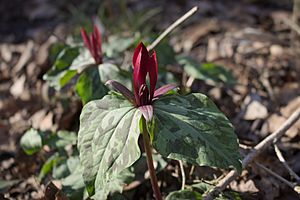Spotted wakerobin facts for kids
Quick facts for kids Spotted wakerobin |
|
|---|---|
 |
|
| A spotted wakerobin plant | |
| Scientific classification | |
| Genus: |
Trillium
|
| Species: |
maculatum
|
| Synonyms | |
|
|
Trillium maculatum, often called the spotted wakerobin or spotted trillium, is a type of flowering plant. It belongs to the Melanthiaceae family. You can find this plant growing naturally only in the eastern United States. It lives in states like Alabama, Georgia, South Carolina, North Carolina, and northern Florida.
Contents
What is the Spotted Wakerobin?
The Trillium maculatum gets its "spotted" name from its unique look. Its leaves and stems often have dark, irregular spots or blotches. These spots make it easy to tell apart from other plants.
This plant is a perennial herbaceous plant. This means it lives for more than two years and does not have a woody stem. It grows back each year from its roots.
When Does it Bloom?
The spotted wakerobin is one of the first plants to flower in spring. It usually blooms from early February to early April. Its flowers are quite striking.
Most often, the petals are a deep red or reddish-purple color. But sometimes, you might find a plant with yellow flowers! These different colors add to the beauty of the plant.
Where Does it Live?
The spotted wakerobin is native to the southeastern parts of the United States. It prefers to grow in woodlands. You can often find it in forests that have rich, moist soil.
It thrives in areas where it can get some sunlight but is also protected by the shade of taller trees. This plant is an important part of the forest ecosystem in these regions.
Life Cycle of the Spotted Trillium
Like many perennial plants, the spotted trillium has an interesting life cycle. It starts growing in late winter or early spring. This is when its leaves and flowers emerge from the ground.
After flowering, the plant produces seeds. These seeds are often spread by ants, which helps the plant grow in new places. Once the seeds are ready, the plant's leaves will die back in the summer. The plant then rests underground until the next spring.
This cycle allows the spotted trillium to survive cold winters and hot summers. It is a resilient and beautiful part of the forest floor.

